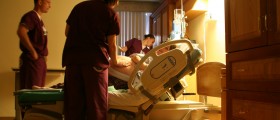
An abortion is the termination of a pregnancy by the removal of a fetus or embryo from uterus, resulting in its death. A pregnancy can be deliberately aborted in many ways. An abortion is medically referred to as therapeutic when it is performed to save the life of a patient or preserve woman’s mental health, prevent born of a child with congenital disorder or in order to reduce the number of fetuses and lessen the risks related with multiple pregnancy. Abortion may also be elective when it is performed at the request of the woman.
Abortion methods
Most commonly used abortion methods are medical and surgical abortion. Medical abortions use pharmaceutical drugs and they are effective only in the first trimester of pregnancy. Surgical abortions divide in a number of types. The most appropriate type for a patient is based on a stage of pregnancy woman is at. According to this surgical procedures are:
Suction-aspiration procedures are effective in up to three months of pregnancy. These are the most commonly conducted types of surgical abortions. Up to 80% of all abortions happen this way. It is performed by sucking the fetus out of the uterus trough a plastic tube and into a bottle.
Dilation and Curettage is most commonly performed in second and third month of pregnancy. It is similar to the suction method but it also involves a knife that is used to cut the fetus apart. Fetus is then grated out through the cervix.
Dilatation and Evacuation is effective up to four months of pregnancy. It involves inserting the forceps and grabbing the body of the fetus to tear it apart and remove from the uterus. After 12 weeks of pregnancy it may be needed to crush the scull in order to complete removal.
Saline abortion may be used from fourth to seventh month of pregnancy. It is carried out by injecting the salt solution into the womb. By that period fetus has the ability to breathe so it inhales the solution and slowly poisons and suffocates. Furthermore, the salty solution burns the skin on the fetus. Death occurs up to one or two hours after the injection. Afterwards, mother goes into labor and delivers a dead fetus.
Prostaglandin abortion may be performed from fourth to eight month of pregnancy by injecting the prostaglandins, hormones needed for birth, into the womb. This provokes premature birth and fetus usually dies from the trauma.
Hysterotomy may be conducted in from sixth to eight month of pregnancy. It uses the method of Cesarean section to extract and kill a fetus (by drowning it in a bucket of water, and suffocating with the placenta or cutting the cord while it is still in the uterus depriving it of oxygen)
Partial birth abortion or Dilation and Extraction, is method most commonly used from fore and a half months up to eight months of child-bearing. This is the newest introduced method that involves completely delivering body of the fetus while the head remains inside of the mother. A sharp instrument is then being used to make an opening on the skull so that the brain can be sucked out. Afterwards, the skull is being crushed and the rest of the body extracted.
What happens to the aborted fetuses?
Aborted fetuses are most commonly dumped into plastic bags for disposal or sold by the bag for fetal transplants and testing. Sometimes their cells are being used for the unproved function to treat patients with diabetes, Alzheimer's and Parkinson's disease.
It might be very disturbing to know that human fetus experiences pain from 8-10 weeks of development.
Possible complications
As much as 100 possible physical complications are associated with abortion. Many of them may occur even 10 to 15 years later.
Infections are most common complications of surgical abortions. In some cases they could even be fatal. Some of the infections are caused by failure to extract all products of conception: the limb, skull or other parts of the fetus. Perforation of the uterus may also occur from manipulation of surgical instruments.
Abortion is an abnormal process for which the body cannot be prepared so it often results in embolisms or obstructions of a blood vessel by foreign substances result from aggressive surgical approach.
Bleeding and anesthetic complications are common as well and they may often have fatal results, especially if abortion clinics have little equipment and proficiency in dealing with them.
















-Why-Some-Women-Take-This-Type-Of-Progesterone-During-Early-Pregnancy_f_280x120.jpg)
Your thoughts on this
Loading...